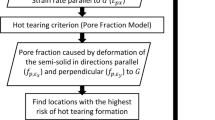Abstract
The transient nature of the start-up phase is the most critical phase in the direct chill (DC) casting during which the quality of the ingot is questioned. The hot crack and cold crack are the two major problems in the DC casting which originate during and after the solidification. In this work, the thermal, metallurgical, and the mechanical fields of DC casting are modeled. The attention is focused on the mushy state of alloy where the chances are high for the hot tearing. The heat conduction and metallurgical phase-change phenomenon are modeled together in a strongly coupled manner. An isothermal staggered approach is followed to couple the thermal and mechanical parts within a time step. Finite element method is used to discretize the thermal and mechanical field equations. A temperature-based fixed grid method is followed to incorporate the latent heat. The mushy state of alloy is characterized through the Norton-Hoff viscoplastic law and the solid phase is modeled through the Garafalo law. An axisymmetric round billet is simulated. The casting material is considered as AA1201 aluminum alloy. It is found that all the components of stress and viscoplastic strain are maximum at the billet center. Further, the start-up phase stresses and strains are always higher than the steady state phase. Therefore, the chances of hot crack formation are higher during the start-up phase and specifically at the billet center. It is proved that through the ramping procedure, the vulnerability of start-up phase can be lowered.
Similar content being viewed by others
References
M’Hamdi M, Benum S, Mortensen D, Fjæ H G and Drezet J M, Metal Mater Trans A, 34-A (2003) 1941.
Suyitno, Kool W H and Katgerman L, Metal Mater Trans A, 35-A (2004) 2917.
Drezet J M and Rappaz M, Metal Mater Trans A, 27 (1996) 3214.
Nallathambi A K, Theromechanical simulation of direct chill casting, Ph D Thesis, Otto von Guericke University Magdeburg, Germany (2010) ISBN 978-3-86912-102-4.
Nallathambi A K, Kaymak Y, Specht E and Bertram A, J ASTM Int, 6 (2009) JAI101806.
Nallathambi A K, Specht E and Bertram A, Comp Mater Sci, 47 (2009) 332.
Celentano D, Onate E and Oller S, Int J Numer Meth Eng, 37 (1994) 3441.
Simo J C and Hughes T J R, Computational Inelasticity, Springer Verlag, New York (1997).
Williams A J, Croft T N and Cross M, Metal Mater Trans B, 34 (2003) 727.
Saleeb A F, Wilt T E and Li W, Comput Mech, 21 (1998) 429.
Author information
Authors and Affiliations
Corresponding author
Rights and permissions
About this article
Cite this article
Nallathambi, A.K., Tyagi, M., Specht, E. et al. Thermomechanical analysis of direct chill casting using finite element method. Trans Indian Inst Met 64, 13 (2011). https://doi.org/10.1007/s12666-011-0003-y
Received:
Revised:
Accepted:
Published:
DOI: https://doi.org/10.1007/s12666-011-0003-y




